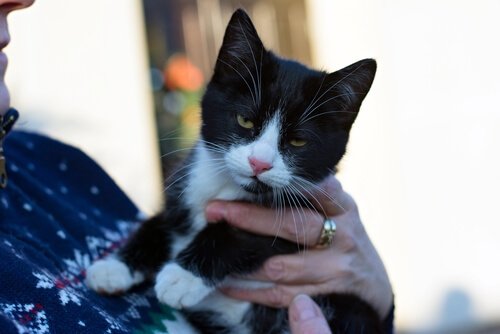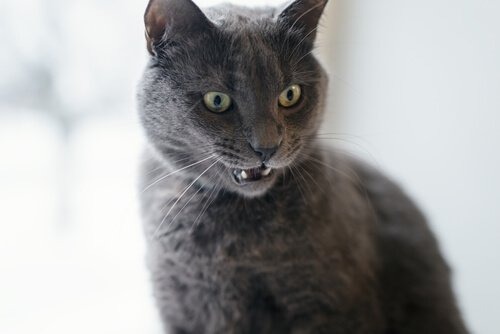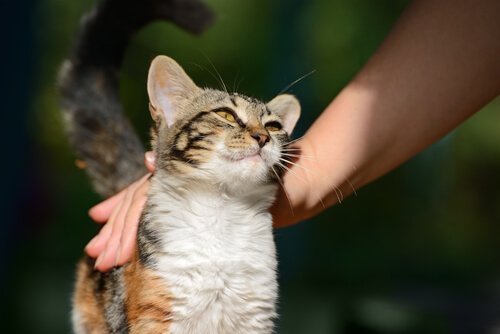A Study On How Cats Communicate With Their Owners

There are many ways that animals can express themselves. Animals can also express themselves through sound, and movements of the tail or ears. This can tell us how they are feeling or what they think about something. In this article, we will tell you about a study to show how cats communicate with their owners. It is very interesting research!
How cats communicate with their owners using their tails
Depending on how your cat moves its tail, you will know if your pet is afraid, angry, alert or happy.

Pay attention to the following tail movements and their meanings:
- Lifted vertically without moving: this means that the cat is not interested in what you are saying or doing and that it will continue on its way.
- Vibrating: when the cat wants to call your attention, show affection or demonstrate its joy, usually when it is time for food. This movement is often accompanied by purring.
- Slow movements from one side to the other: this movement means that the cat is very happy, comfortable and feels safe in its surroundings. Congratulations … your cat is enjoying your company.
- Horizontal (parallel to the ground): the cat is feeling both confident and distrustful with what is happening in its surroundings. This is a position that the cat takes when it is alert.
- Low to the ground: when holding its tail low to the ground, the cat is likely to be walking very slowly, crouching and opening its eyes wide. This is the typical stance of cats used when hunting or playing a game.
Other tail movements and their meanings:
- Fast movements to from side to side: if the cat’s tail moves from one side to the other, it means that the cat is interested in something or someone. If the ears are raised at the same time, the cat is demonstrating even more interest.
- Diagonal and rigid: the cat’s back is slightly arched and the tail is fully erect. This means that there is something that disturbs or scares the cat.
- Raised with the tip of the tail retracted: this motion is the cat’s way of saying that although it is being friendly, it is equally cautious. In addition, the cat does not feel unprotected at the moment but is taking precautions, just in case.
- Thumping on the ground: the movement of the tail is fast, short and restless. This happens when the cat is nervous, alert or afraid (for example when it rains, during loud noises or greeting unknown visitors).
- Down (with raised hind legs): the cat is in a stressful situation in which it needs to defend itself.
- Between the hind legs: this is the position of a fearful, submissive or respectful cat. Usually the cat places its tail in this way when it is being scolded or there are other animals in greater authority.
- Hair on end: this means that the cat is very angry, uncomfortable and irritated. When the cat is in this position, it is better not to get close, because it can hurt you.
How cats communicate with their owners through their facial movements
Another good way to understand your cat is to pay attention to its facial expressions (especially movements in the eyes and ears):
- Ears still and open to the outside: First, the brow is furrowed, which means that the cat is upset, irritated or even furious. It is essential that you let the cat go until this expression has passed.
- Ears standing forward: The eyes do not show pupil dilation. This is a sign of calmness or sleepiness, and means that the cat is confident and comfortable.
- Ears forward, eyes slanted: If the cat is squinting its eyes and pointing its ears the same way, this is a good sign. This expression serves to communicate comfort, relaxation and availability for games and caresses.
- Low Ears and Dilated Eyes: This expression may mean that the cat is excited, that something is catching its attention or that it is angry. What’s more, if you insist on approaching the cat during this phase, it will usually quickly run away from you.
How cats communicate with their owners using sound

A third method that cats can use to communicate is without a doubt by using sound. Depending on the tones or volumes that the cat uses, the cat is trying to communicate one thing or another.
A meow has many different meanings. For example, if the cat gently meows, it could mean that the cat is happy or greeting you (this meaning is accompanied by purring, slow movements of the tail and rubbing its body against you). If the cat is meowing strongly, and continuously moving its puffed-out tail, it is better to leave it alone because the cat is angry. And if the cat is meowing repetitively and the meows are increasing in tone, this could mean that the cat wants something, most likely food.
And finally, purring is another way that cats express themselves. In this case, purring was the original way to form a bond between the mother cat and the kitten. The cat continues to use this technique throughout its life to show affection.
A purr is the cat’s most tender and loving characteristic. Purring is a sign of trust and one that cat owners should never underestimate.